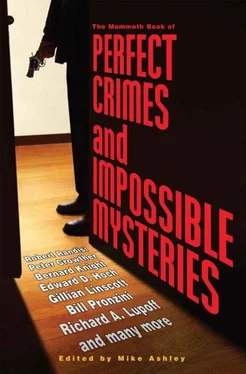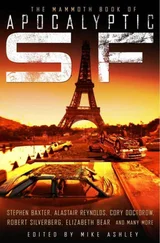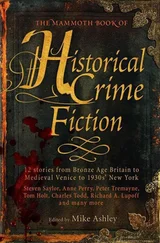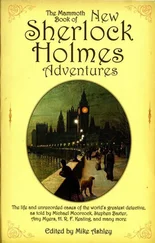The second solution, about approach from the sea, however, did excite him. The only question was whether such a feat was possible at the private beach. One way to settle that was to check with Sammy Ames, sports editor of the local paper, a buff on water games. Ader gave him a call, while I listened in, conference style. Ames was very emphatic. Nobody unwilling to commit suicide would swim within five miles of that coast at this time of the year. The undercurrents made it physically impossible to survive there; not even an Olympic gold medalist could manage it.
That was bad enough, but a call to the Yacht Club brought further verification, plus the fact that some footprints would have been left, at least until the evening tide came in.
It was hard enough finding those two theories; now I had to come up with a third, and it had to be a better one. That made a visit to the house mandatory, so I asked the lieutenant to take me there.
The place was quite impressive: a big, roomy, two-story mansion, with stairs in the back leading down some sixty feet of rock to the private beach. That beach was bounded with those minor precipices on three sides, and the sea itself on the fourth.
I won’t waste time describing the family, since their physical qualities are not relevant. All the men were healthy, athletic types, strongly masculine. They seemed genuinely sorry for Larry, but certain he was guilty.
The collection of medieval arms would have made the visit worthwhile in less harrowing circumstances. The walls were lined with daggers, battle-axes, bills, pikes, crossbows, and other ancient man-killers. There were several dummies in full suits of armor, beautifully burnished. Wheeler, the curator of this family museum, was obviously proud of the collection, and had become a trained specialist on medieval warfare through his research for the colonel. He enthusiastically demonstrated the correct use of several outlandish weapons, handling them with the assurance of an expert.
But none of this was clearing up the mystery – if there was one, and Larry didn’t happen to be our murderer.
Well, I was pretty discouraged at this point. Maybe John Dickson Carr can make up and solve these locked room puzzles on paper, but this was too much for me. I was ready to throw in the sponge, and go back to Larry as the killer.
But then I recalled other recent cases Ader and I had worked on. In those, a fresh appraisal of the evidence broke the impasse. Besides, I liked Dana. And it makes a difference, when you have a personal interest in an investigation.
So back I went to the lab. The first thing I did was re-read my notes on the autopsy. They didn’t change a thing. The colonel’s skull had been fractured just above the right ear. I tried to visualize how the blow might have been struck. If the killer had stood to the right of, and just behind the old man, lying there with his feet towards the sea, and made a golf-like swing from right to left, with the knobby end of the stick down, hands near the ferrule, that would account for the injury. Nothing unlikely there; no inconsistencies to take hold of.
Rather gloomily, I turned to the remaining evidence, the stick itself. I held it in the way I had pictured it, and tried to re-enact the fatal swing. Suddenly I felt a surge of hope. The blood and hair were in the wrong place! If the stick had been swung, like a golf-club, by a standing man, the side should be stained. In fact, that would be true no matter how the thing was manipulated as a bludgeon. But instead, the very top of the handle had the blood and hair. How was that possible?
Excited, I experimented again. The only way to hit a person with the top of the knob would be to make a spear-like thrust forward with it. But that would be awkward and unlikely even if enough power was possible, something I doubted. Then a whole new prospect opened before me, one that suggested many significant modifications of our interpretation of the evidence. That stick hadn’t been used as a club at all. It must have been projected like a spear, knob first. But how? Certainly nobody could actually throw the thing, like a lance, with sufficient force and accuracy to kill a man from – how many feet? I checked the drawing again. The body was almost forty feet from the foot of the stairs, which is where the murderer would have had to stand in order to avoid tracking up the sand. Such a throw was utterly fantastic by sheer muscle power. The skull has thick bones, not easily fractured.
Then, looking at that long, slender body of the stick, I had an idea. I grabbed my lens and studied the metal ferrule. Sure enough, there were two shallow but definite grooves across the tip. They could have only one explanation; in them a taut string would not slip off the end of the ferrule. That meant a crossbow – it seemed obvious, now. What could be simpler than placing the narrow ebony rod in the slot of a strung crossbow, knob forward, and then, from a position on the stairs, aiming at the man lying there on the sand. The stick, propelled with all the force of a powerful metal leaf spring, would strike a terrific blow on the victim’s head.
I began to pace the floor feverishly. A perfect solution; one that explained everything. So that’s why there were no other tracks. The killer didn’t need to leave the stairs. What no mere arm could do, the crossbow made easy. Aiming one was no harder than pointing a rifle, and forty feet was a short range. Even so, the murderer must have practiced a bit to make sure. Perhaps he hadn’t hoped to convict Larry, but merely to confuse the issue.
All right, he shot the strange arrow, then leaving it by the body – I cursed. Another good theory gone to pot. The stick had not remained by the corpse. How did the marksman recover it without leaving tracks?
I thought of a string, say a nylon fishline, tied to the missile. But another peek at the photos ruined that solution. There was no long, narrow trail in the soft sand to show where the stick was hauled back.
But I knew there must be some explanation; the rest fitted too well. I examined the stick again, starting at the ferrule. In the middle of the polished stem, I found some indentations. They were not deep, but then the wood is very hard. I measured them, and noticed their spacing. There were no others like them; obviously, Larry took good care of his prize possession. It was baffling, especially because I felt that I was getting close.
Then, seeing the photo again, it came to me. The sort of thing I should have spotted immediately. But any theory needs testing, so I called Ader, and asked him to meet me at the beach. He was to get, on the Q.T., one of the non-suspects, say the housekeeper, to bring Gustavus Adolphus, the coach dog. I wanted somebody the animal knew, and would obey. Since she fed him, that was no problem. He knew and obeyed her.
At the beach, I showed Ader the marks on the stick, and explained the crossbow theory.
“Those marks have been made by teeth,” I told him. The Dalmatian was racing about, happy to be out on the beach again for a romp along the shore. At our request the housekeeper, a little bewildered but willing, stood on the stairs and flung the ebony stick end over end towards the water. “Fetch, Gustavus!” she shrilled, and barking joyously, the spotted dog raced out, seized it with his mouth, and carried it to the woman.
I grinned at the lieutenant.
“That completes the story. When the old man was dead, and the killer stood where she is now, all he had to do was shout ‘Fetch!’ and the dog retrieved the murder weapon. A wordless accomplice. Neat. No footprints on the sand.”
“He was sure a lot of help to the poor colonel,” Ader snapped, giving the clumsy hound an indignant glare. “Instead of chewing up the murderer, he helps the guy get away with it. Or almost.”
Читать дальше











